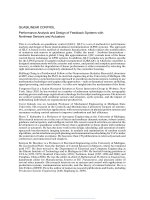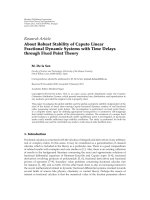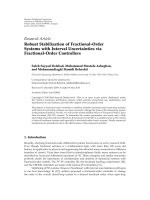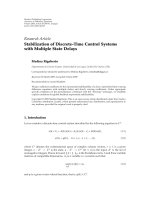Robust control systems with genetic algorithms (1)
Bạn đang xem bản rút gọn của tài liệu. Xem và tải ngay bản đầy đủ của tài liệu tại đây (4.48 MB, 220 trang )
CONTROL SERIES
Robert H. Bishop
Series Editor
University of Texas
Austin, Texas
Published Titles
Linear Systems Properties: A Quick Reference Guide
Venkatarama Krishnan
Robust Control Systems and Genetic Algorithms
Mo Jamshidi, Renato A Krohling, Leandro dos Santos Coelho,
and Peter J. Fleming
Sensitivity of Automatic Control Systems
Efim Rozenwasser and Rafael Yusupov
Forthcoming Titles
Material and Device Characterization Measurements
Lev I. Berger
Model-Based Predictive Control: A Practical Approach
J.A. Rossiter
CRC Press
Taylor & Francis Group
6000 Broken Sound Parkway NW, Suite 300
Boca Raton, FL 33487-2742
© 2003 by Taylor & Francis Group, LLC
CRC Press is an imprint of Taylor & Francis Group, an Informa business
No claim to original U.S. Government works
Version Date: 2011928
International Standard Book Number-13: 978-1-4200-5834-5 (eBook - PDF)
This book contains information obtained from authentic and highly regarded sources. Reasonable
efforts have been made to publish reliable data and information, but the author and publisher cannot
assume responsibility for the validity of all materials or the consequences of their use. The authors and
publishers have attempted to trace the copyright holders of all material reproduced in this publication
and apologize to copyright holders if permission to publish in this form has not been obtained. If any
copyright material has not been acknowledged please write and let us know so we may rectify in any
future reprint.
Except as permitted under U.S. Copyright Law, no part of this book may be reprinted, reproduced,
transmitted, or utilized in any form by any electronic, mechanical, or other means, now known or
hereafter invented, including photocopying, microfilming, and recording, or in any information storage or retrieval system, without written permission from the publishers.
For permission to photocopy or use material electronically from this work, please access www.copyright.com ( or contact the Copyright Clearance Center, Inc. (CCC), 222
Rosewood Drive, Danvers, MA 01923, 978-750-8400. CCC is a not-for-profit organization that provides licenses and registration for a variety of users. For organizations that have been granted a photocopy license by the CCC, a separate system of payment has been arranged.
Trademark Notice: Product or corporate names may be trademarks or registered trademarks, and are
used only for identification and explanation without intent to infringe.
Visit the Taylor & Francis Web site at
and the CRC Press Web site at
1251 Front Matter.fm Page v Wednesday, August 21, 2002 9:44 AM
Dedications
In memory of my fathers: Habib Jamshidi and General Morteza Salari
Mo Jamshidi
For my mother Hilda Stern Krohling
and in memory of my father Daniel Krohling
Renato Krohling
For Viviana
Leandro dos Santos Coelho
For Steph, Joss, and Sam
Peter J. Fleming
1251 Front Matter.fm Page vi Wednesday, August 21, 2002 9:44 AM
1251 Front Matter.fm Page vii Wednesday, August 21, 2002 9:44 AM
Preface
Since the early days of the latter part of the last century, optimization has
been an integral part of many science and engineering fields such as mathematics, operations research, control systems, etc. A number of approaches
have existed to bring about optimal behavior in a process of plant. Traditionally, mathematics is the basis for many optimization approaches, such
as optimal control with such celebrated theoretical results such as Pontryagin’s maximum principle, Hamilton–Jacobi–Bellman sufficiency equation,
Kuhn–Tucker conditions, etc. In recent times, we have witnessed a new
paradigm for optimization — a biologically inspired approach has arrived
that is based on the natural evolution of populations to Darwin’s principle
of natural selection, “survival of the fittest,” and Mendel’s genetics law of
transfer of the hereditary factors from parents to descendants.
The principal player in this evolutionary approach to optimization is
known as genetic algorithms (GA), which was developed by Holland in
1975, and is based on the principles of natural selection and genetic modification. GA are optimization methods, which operate on a population of
points, designated as individuals. Each individual of the population represents a possible solution of the optimization problem. Individuals are evaluated depending upon their fitness. The fitness indicates how well an individual of the population solves the optimization problem. Another paradigm
is based on optimization of symbolic codes, such as expert rules of inference,
and is known as genetic programming (GP), first suggested by Koza in 1992.
GP is an extension of the GA for handling complex computational structures.
The GP uses a different individual representation and genetic operators and
an efficient data structure for the generation of symbolic expressions, and it
performs symbolic regressions. The solution of a problem by means of GP
can be considered a search through combinations of symbolic expressions.
Each expression is coded in a tree structure, also called a computational
program, that is subdivided into nodes and presents a variable size.
One of the popular approaches to the mathematics-based approach to
optimal design of a control system has been robust optimal control, in which
an objective function, often based on a norm of a functional, is optimized,
while a controller (dynamic or static) is obtained that can tolerate variation
of plant parameters and unordered dynamics.
1251 Front Matter.fm Page viii Wednesday, August 21, 2002 9:44 AM
The object of this volume is to build a bridge between genetic algorithms
and robust control design of control systems. GA is used to find an optimal
robust controller for linear control systems. Optimal control of robotic
manipulators, flexible links, and jet engines are among the applications
considered in this book.
In Chapter 1, an introduction to genetic algorithms is given, showing
the basic elements of this biologically inspired stochastic parallel optimization method. The chapter describes the genetic operators: selection, crossover, and mutation, for binary and real representations. An example of how
genetic algorithms work as an optimizer is provided, followed by a short
overview of genetic programming.
Chapter 2 is devoted to optimal design of robust control systems and
addresses issues like robust stability and disturbance rejection. First, by
means of the H∞- norm, two conditions are described, one for robust stability
and one for disturbance rejection. Finally, the design of optimal robust controllers and the design of optimal disturbance rejection controllers, both with
fixed structure, are formulated as a constrained optimization problem. The
problem consists of the minimization of a performance index (the integral
of the squared-error or the integral of the time-weighted-squared-error) subject to the robust stability constraint or the disturbance rejection constraint,
respectively. The controller design, therefore, consists in the solution of the
constrained optimization problems.
Chapter 3 is concerned with new methods to solve these optimization
problems using genetic algorithms. The solution contains two genetic algorithms. One genetic algorithm minimizes the performance index (the integral
of the squared-error or the integral of the time-weighted-squared-error) and
the other maximizes the robust stability constraint or the disturbance rejection constraint. The entire design process is described in the form of algorithms. The methods for controller design are evaluated, and the advantages
are highlighted.
Chapter 4 deals with model-based predictive control and variable structure control designs. The basic concepts and formulation of generalized
predictive control based on optimization by genetic algorithms are presented
and discussed. The variable structure control design with genetic optimization for control of discrete-time systems is also presented in this chapter.
Chapter 5 is devoted to the development of a genetic algorithm to the
design of generalized predictive control and variable structure systems of
quasi-sliding mode type. The simulation results for case studies show the
effectiveness of the proposed control schemes.
Chapter 6 discusses the use of fuzzy logic in controllers and describes
the role of genetic algorithms for off-line tuning of fuzzy controllers. As an
example application, a fuzzy controller is developed and tuned for a gas
turbine engine.
Chapters 7 and 8 take on the application of hybrid approaches such as
GA-Fuzzy and Fuzzy-GP to robotic manipulators and mobile robots with
some potential applications for space exploration. The fuzzy behavior control
1251 Front Matter.fm Page ix Wednesday, August 21, 2002 9:44 AM
approach with GP enhancement or fuzzy control optimized by a GA is
among the key topics in these two chapters.
Chapter 9 addresses the simultaneous optimization of multiple competing design objectives in control system design. A multiobjective genetic
algorithm is introduced, and its application to the design of a robust controller for a benchmark industrial problem is described.
In Appendix A, we cover the fundamental concepts of fuzzy sets, fuzzy
relation, fuzzy logic, fuzzy control, fuzzification, defuzzification, and stability of fuzzy control systems. This appendix is provided to give background
to the readers who may not be familiar with fuzzy systems, and it is a
recommended reading before Chapters 6 through 8.
Mo Jamshidi would like to take this opportunity to thank many peers
and colleagues and current and former students. In particular, much appreciation is due to two of the former doctoral students of the first author, Dr.
Edward Tunstel of NASA Jet Propulsion Laboratory (Pasadena, California)
whose fuzzy-behavior control approach was the basis for Chapter 8, as well
as Dr. Mohammad Akbarzadeh-Totoonchi of Ferdowsi University (Mashad,
Iran), whose interests in GA always inspired the first author and whose work
on GA-Fuzzy control of distributed parameter systems made Chapter 7
possible. He wishes to express his heart-felt appreciation to his family, especially his loving wife Jila, for inspiration and constant support.
Renato A. Krohling wishes to kindly thank his family for their constant
support and their motivation throughout his career. He wishes to thank LAIUFES, the Intelligent Automation Laboratory, Electrical Engineering Department, UFES, Vitória-ES, Brazil, for their support of his work. He would like
to especially thank the guidance and mentorship of Professor H.J.A. Schneebeli, his MS degree advisor, and the coordinators of the Programa de PúsGraduaỗóo em Engeharia Elétrica, UFES.” A great part of the research of
Chapters 1 to 3 was prepared when he was a doctoral student at the University of Saarland, Germany, and he appreciates the guidance of his advisor
Professor H. Jaschek. In the last few years, he has also carried out some
works with Professor J.P. Rey, NHL, Leeuwarden, the Netherlands, and
thanks him for very useful “scientific hints.” He wishes to thank the Brazilian
Research Council, “Conselho Nacional de Pesquisa e Desenvolvimento
Científico e Tecnológico (CNPq),” for their financial support. He wishes to
thank his nephew Helder for art works, his brothers and sisters of KAFFEE
Exp. & Imp. Ltd., Santa Maria, ES, for their financial support, allowing his
stay in the United States, hosted by first author, Mo Jamshidi, Director of
the ACE Center, the University of New Mexico, during the summer of 2000.
Leandro dos S. Coelho wishes to thank his wonderful wife and his family
for their love, support and encouragement. He wishes to thank Programa
de Pús-Graduaỗóo em Engenharia de Produỗóo e Sistemas, Pontifớcia Universidade Catúlica do Paranỏ, for their support of his work. He would like
to especially thank Professor Antonio Augusto Rodrigues Coelho, his doctoral degree advisor, at Federal University of Santa Catarina, Brazil. He also
wishes to thank the Brazilian Research Council, “Conselho Nacional de
1251 Front Matter.fm Page x Wednesday, August 21, 2002 9:44 AM
Pesquisa e Desenvolvimento Científico e Tecnológico (CNPq),” for the financial support during his doctoral studies.
Peter Fleming is indebted to two of his former doctoral students, Beatrice
Bica and Ian Griffin, for permission to use some of their excellent research
results in Chapters 6 and 9, respectively. He also wishes to take this opportunity to thank all the researchers who have contributed to make the Badger
Lane research laboratory such a vibrant and productive environment during
the last ten years.
The encouragement and patience of CRC Press LLC Editor Nora
Konopka is very much appreciated. Without her continuous help and assistance during the entire course of this project, we could not have accomplished the task of integrating GA and robust control under the cover of this
volume. We would also like to thank the patient collaboration and helpful
assistance of Jamie Sigal and Joette Lynch of CRC Press through the production phase of the book and their commitment and skillful effort of editing
and processing several iterations of the manuscript. Finally, we would like
to thank Dr. Robert H. Bishop, the Series Editor of this volume for the
valuable reviews of the manuscripts and helpful suggestions during the
initial stages of the book. Last, but not least, the authors would like to thank
their families for their understanding, love, and patience during this project.
Mo Jamshidi
Albuquerque, New Mexico, United States
Renato A. Krohling
Vitória Espírito Santo, Brazil
Leandro dos S. Coelho
Curitiba, Brazil
Peter Fleming
Sheffield, United Kingdom
1251 Front Matter.fm Page xi Friday, April 29, 2005 1:02 PM
Table of Contents
Chapter one Genetic algorithms ...................................................................1
1.1 Introduction to genetic algorithms ..................................................1
1.2 Terms and definitions ........................................................................2
1.3 Representation ....................................................................................4
1.3.1 Genetic algorithms with binary representation ...............4
1.3.2 Genetic algorithms with real representation ....................4
1.4 Fitness function ................................................................................... 5
1.5 Genetic operators ................................................................................7
1.5.1 Selection ..................................................................................7
1.5.1.1 Proportionate selection .........................................7
1.5.1.2 Tournament selection ............................................8
1.5.2 Crossover ................................................................................8
1.5.2.1 Crossover for binary representation ...................9
1.5.2.2 Crossover for real representation ........................9
1.5.3 Mutation ...............................................................................10
1.5.3.1 Mutation for binary representation ..................10
1.5.3.2 Mutation for real representation .......................10
1.6 Genetic algorithms for optimization ............................................. 11
1.6.1 Genetic algorithms at work ............................................... 11
1.6.2 An optimization example ...................................................12
1.7 Genetic programming ...................................................................... 13
1.8 Conclusions .......................................................................................15
References......................................................................................................16
Chapter two Optimal robust control ...........................................................19
2.1 Introduction to the control theory .................................................19
2.2 Norms of signals and functions ..................................................... 22
2.3 Description of model uncertainty ..................................................23
2.4 Robust stability and disturbance rejection ...................................25
2.4.1 Condition for robust stability ............................................25
2.4.2 Condition for disturbance rejection .................................27
2.5 Controller design ..............................................................................29
2.5.1 Optimal controller design ..................................................30
2.5.2 Optimal robust controller design .....................................32
2.5.3 Optimal disturbance rejection controller design ...........33
1251 Front Matter.fm Page xii Wednesday, August 21, 2002 9:44 AM
2.6
Optimization .....................................................................................33
2.6.1 The optimization problem .....................................................33
2.6.2 Constraint handling ................................................................34
2.7 Conclusions .......................................................................................36
References......................................................................................................37
Chapter three Methods for controller design using genetic
algorithms ..................................................................................................... 39
3.1 Introduction to controller design using genetic algorithms .....39
3.2 Design of optimal robust controller with fixed structure.......... 39
3.2.1 Design method ....................................................................41
3.2.2 Design example ...................................................................42
3.3 Design of optimal disturbance rejection controller with fixed
structure .............................................................................................48
3.3.1 Design method ....................................................................50
3.3.2 Design example ...................................................................51
3.4 Evaluation of the methods ..............................................................58
3.5 Conclusions .......................................................................................59
References......................................................................................................59
Chapter four Predictive and variable structure control designs ...........61
4.1 Model-based predictive controllers ...............................................61
4.1.1 Basic concepts and algorithms ..........................................62
4.1.2 Generalized predictive control ..........................................63
4.1.2.1 Formulation and design of GPC .......................63
4.1.2.2 Overview of optimization of GPC design by
genetic algorithms ...............................................67
4.2 Variable structure control systems ................................................68
4.2.1 Introduction.......................................................................... 68
4.2.2 Basic concepts and controller design ...............................71
4.2.3 Overview of optimization of variable structure control
design by genetic algorithms ............................................74
References......................................................................................................75
Chapter five Design methods, simulation results, and conclusion ......79
5.1 Optimization of generalized predictive control design by
genetic algorithms ............................................................................79
5.1.1 Design method ....................................................................79
5.1.2 Design example ...................................................................80
5.1.3 Simulation results ................................................................82
5.1.3.1 Case study 1: Adaptive GPC design without
constraints ............................................................. 82
5.1.3.2 Case study 2: Adaptive GPC design with
constraints for the control signal ......................82
5.2 Optimization of quasi-sliding mode control design by genetic
algorithms ..........................................................................................85
1251 Front Matter.fm Page xiii Wednesday, August 21, 2002 9:44 AM
5.2.1
5.2.2
5.2.3
Design method ....................................................................85
Design example ...................................................................86
Simulation results ................................................................88
5.2.3.1 Case study 1: Self-tuning quasi-sliding mode
control ....................................................................88
5.2.3.2 Case study 2: Self-tuning quasi-sliding mode
control with gain scheduling .............................91
5.3 Conclusions .......................................................................................95
References......................................................................................................97
Chapter six Tuning fuzzy logic controllers for robust control system
design ............................................................................................................99
6.1 Introduction .......................................................................................99
6.2 Fuzzy control ..................................................................................100
6.3 Genetic tuning of fuzzy control systems ....................................101
6.4 Gas turbine engine control ...........................................................103
6.4.1 Gas turbine engines — an overview .............................103
6.4.2 GTE types ...........................................................................104
6.4.3 The GTE control problem ................................................ 105
6.5 Fuzzy control system design — example study ....................... 107
6.5.1 Problem formulation ........................................................107
6.5.2 Heuristic design of the fuzzy controllers ......................108
6.5.3 GA tuning of the fuzzy controllers ................................ 112
6.6 Applications of GAs for fuzzy control ....................................... 114
References.................................................................................................... 116
Chapter seven GA-fuzzy hierarchical control design approach ......... 119
7.1 Introduction ..................................................................................... 119
7.2 Hierarchical fuzzy control for a flexible robotic link ...............122
7.2.1 A mathematical model .....................................................122
7.2.2 Separation of spatial and temporal parameters ...........124
7.2.3 The second level of hierarchical controller ...................124
7.2.3.1 Line-curvature analysis ....................................125
7.2.3.2 The rule base ......................................................125
7.2.4 The lower level of hierarchy ...........................................126
7.3 Genetic algorithms in knowledge enhancement .......................127
7.3.1 Interpretation function .....................................................127
7.3.2 Incorporating initial knowledge from one expert .......128
7.3.3 Incorporating initial knowledge from several experts 130
7.4 Implementation issues ...................................................................130
7.4.1 Software aspects ................................................................130
7.4.2 Hardware aspects ..............................................................131
7.5 Simulation ........................................................................................132
7.6 Conclusions .....................................................................................134
References....................................................................................................135
1251 Front Matter.fm Page xiv Wednesday, August 21, 2002 9:44 AM
Chapter eight Autonomous robot navigation through fuzzy-genetic
programming .............................................................................................137
8.1 Introduction .....................................................................................137
8.2 Hierarchical fuzzy-behavior control ...........................................138
8.2.1 Behavior hierarchy ............................................................139
8.3 Coordination by behavior modulation .......................................141
8.3.1 Related work ......................................................................142
8.4 Genetic programming of fuzzy behaviors .................................143
8.4.1 Rule discovery ...................................................................143
8.5 Evolution of coordination .............................................................144
8.5.1 Behavior fitness evaluation .............................................144
8.6 Autonomous navigation results ...................................................145
8.6.1 Hand-derived behavior ....................................................146
8.6.2 Evolved behavior ..............................................................148
8.7 Conclusions .....................................................................................150
References....................................................................................................151
Chapter nine Robust control system design: A hybrid
H-infinity/multiobjective optimization approach...............................153
9.1 Introduction .....................................................................................153
9.2 H-infinity design of robust control systems ..............................154
9.2.1 Introduction to H-infinity design ...................................154
9.2.2 Loop-shaping design procedure .....................................155
9.2.3 H-infinity robust stabilization ......................................... 157
9.3 Multiobjective optimization ..........................................................158
9.3.1 Introduction to multiobjective optimization ................158
9.3.2 Multiobjective genetic algorithms ..................................159
9.3.3 Robust control system design: Incorporating
multiobjective with H-infinity ........................................161
9.4 Case study: Robust control of a gasification plant ...................162
9.4.1 Plant model and design requirements........................... 163
9.4.2 Problem formulation ........................................................164
9.4.3 Design using a hybrid H-infinity/multiobjective
optimization approach .....................................................165
9.5 Conclusions .....................................................................................169
References....................................................................................................170
Appendix A Fuzzy sets, logic and control .............................................. 171
A.1 Introduction .....................................................................................171
A.2 Classical sets ....................................................................................172
A.3 Classical set operations .................................................................173
A.4 Properties of classical sets .............................................................174
A.5 Fuzzy sets and membership functions .......................................175
A.6 Fuzzy sets operations ....................................................................177
A.7 Properties of fuzzy sets .................................................................179
1251 Front Matter.fm Page xv Wednesday, August 21, 2002 9:44 AM
A.8 Predicate logic .................................................................................183
A.9 Fuzzy logic ......................................................................................190
A.10 Fuzzy control ..................................................................................192
A.11 Basic definitions ..............................................................................194
A.12 Conclusion .......................................................................................202
References....................................................................................................202
Index ..........................................................................................................203
1251 Front Matter.fm Page xvi Wednesday, August 21, 2002 9:44 AM
1251_CH01.fm Page 1 Wednesday, August 14, 2002 11:44 AM
chapter one
Genetic algorithms
1.1 Introduction to genetic algorithms
The evolutionary theory attributes the process of the natural evolution of
populations to Darwin’s principle of natural selection, “survival of the fittest,” and Mendel’s genetics law of transfer of the hereditary factors from
parents to descendants (Michalewicz, 1996). Genetic algorithms (GA) were
developed by Holland (1975) and are based on the principles of natural
selection and genetic modification. GA are optimization methods, which
operate on a population of points, designated as individuals. Each individual
of the population represents a possible solution of the optimization problem.
Individuals are evaluated depending upon their fitness. Fitness indicates
how well an individual of the population solves the optimization problem.
GA begin with random initialization of the population. The transition
of one population to the next takes place via the application of the genetic
operators: selection, crossover, and mutation. Through the selection process,
the fittest individuals will be chosen to go to the next population. Crossover
exchanges the genetic material of two individuals, creating two new individuals. Mutation arbitrarily changes the genetic material of an individual.
The application of the genetic operators upon the individuals of the population continues until a sufficiently good solution of the optimization problem is found. The solution is usually achieved when a predefined stop
condition, i.e., a certain number of generations, is reached. GA have the
following general features:
• GA operate with a population of possible solutions (individuals)
instead of a single individual. Thus, the search is carried out in a
parallel form.
• GA are able to find optimal or suboptimal solutions in complex and
large search spaces. Moreover, GA are applicable to nonlinear optimization problems with constraints that can be defined in discrete
or continuous search spaces.
1
1251_CH01.fm Page 2 Wednesday, August 14, 2002 11:44 AM
2
Robust Control Systems with Genetic Algorithms
• GA examine many possible solutions at the same time. So, there is a
higher probability that the search converges to an optimal solution.
In the classical GA developed by Holland (1975), individuals are represented by binary numbers, i.e., bit strings. In the meantime, new representations for individuals and appropriate genetic operators have been developed. For optimization problems with variables within the continuous
domain, the real representation has shown to be more suitable. With this
type of representation, individuals are represented directly as real numbers.
For this case, it is not necessary to transform real numbers into binary
numbers. In the following, some terms and definitions are described.
1.2 Terms and definitions
Here is an introduction to common GA terms. Because GA try to imitate the
process of natural evolution, the terminology is similar but not identical to
the terms in natural genetics. A detailed description of the GA can be found
in Goldberg (1989), Michalewicz (1996), Mitchell (1996), Bäck, (1996), and
Fogel (1995).
For GA, population is a central term. A population P consists of individuals ci with i = 1,…,µ:
{
P = c1 ,..., c i ,..., c µ
}
(1.1)
The population size µ can be modified during the optimization process.
In this work, however, it is kept constant.
An individual is a possible solution of an optimization problem. The
objective function f(x) of the optimization problem is a scalar-valued function
of an n-dimensional vector x. The vector x consists of n variables xj, with j
= 1,…,n, which represents a point in real space ℜn. The variables xj are called
genes. Thus, an individual ci consists of n genes:
[
c i = ci 1 ,..., cij ,..., cin
]
(1.2)
In the original formulation of GA, the individuals were represented as
binary numbers consisting of bits 0 and 1. In this case, the binary coding
and the Gray coding can be used. An individual ci coded in binary form is
called a chromosome. In real representation, an individual ci consists of a
vector of real numbers xi.
Another important term is the fitness of an individual. It is the measure
for the quality of an individual in a population. The fitness of an individual
is determined by the fitness function F(x). GA always search for the fittest
individual, so the fitness function is maximized. In the simplest cases, the
fitness function depends on the objective function.
1251_CH01.fm Page 3 Wednesday, August 14, 2002 11:44 AM
Chapter one:
Genetic algorithms
3
The average fitness Fm of a population is determined as follows:
µ
Fm =
∑ F(ci )
i =1
(1.3)
µ
The relative fitness pi of an individual ci is calculated by:
pi =
F(c i )
(1.4)
µ
∑ F(ci )
i =1
Normally, GA begin the process of optimization with a randomly
selected population of individuals. Then, the fitness for each individual is
calculated. Next comes the application of the genetic operators: selection,
crossover, and mutation. Thus, new individuals are produced from this process, which then form the next population. The transition of a population Pg
to the next population Pg+1 is called generation, where g designates the
generation number. In Figure 1.1, the operations executed during a generation are schematically represented. The evolution of the population continues
through several generations, until the problem is solved, which in most cases,
ends in a maximum number of generations gmax.
Pg
Fitness Calculation
Selection
Generation
Crossover
Mutation
Pg+1
Figure 1.1 Representation of the executed operations during a generation.
1251_CH01.fm Page 4 Wednesday, August 14, 2002 11:44 AM
4
Robust Control Systems with Genetic Algorithms
1.3 Representation
In the classical GA, the genetic operators crossover and mutation operate on
bit strings. Therefore, the fitness of individuals can only be calculated after
decoding the bit strings. The next section describes GA with binary and real
representation.
1.3.1
Genetic algorithms with binary representation
Binary representation consists of binary coding and Gray coding. In order
to present the principles of the classical GA, only binary coding is described.
For a description of Gray coding, the reader is referred to Bethke (1981).
Let the objective function be f(x), where the vector x consists of n variable
xi with i = 1,…,n. The lower and upper value of the variables xi is, respectively, given by xi min and xi max. In binary coding, the variable xi is first
converted into a normalized number xi norm:
xi norm =
xi − xi min
xi max − xi min
(1.5)
where 0 ≤ xi norm ≤ 1. Next, the normalized number xi norm is transformed into
a binary number ci. The number of bits required for ci is determined by the
accuracy required. The binary number ci consists, thus, of m bits and is
represented as follows:
ci = b[1],..., b[ j],..., b[m]
with b[ j] ∈{0, 1}
∀j = 1,..., m
(1.6)
The encoding of a normalized number xi norm into the corresponding
binary number ci occurs in accordance with the pseudo-code shown in Figure
1.2.
The decoding of a binary number ci into the correspondent variable xi
occurs in accordance with the pseudo-code shown in Figure 1.3.
1.3.2
Genetic algorithms with real representation
For optimization problems with variables in continuous domain, a representation with real numbers is easier and more direct. An individual ci consists
of a vector of real numbers xi. Each element of the vector corresponds to a
characteristic of the individual, thus, a gene. Therefore, no coding or decoding is needed. This leads to a simpler and more efficient implementation.
The accuracy with real representation depends only on the computer used.
The advantages of the real representation compared to the binary representation are shown in Davis (1991), Wright (1991), and Michalewicz
(1996).
1251_CH01.fm Page 5 Wednesday, August 14, 2002 11:44 AM
Chapter one:
Genetic algorithms
5
Algorithm 1: binary coding
Input: xi norm and m
Output: ci = b[1], … , b[ j], … , b[m]
Auxiliary variable: j and q j
begin
j = 1 and q j = xi norm
while ( j ≤ m) do
(
if q j − 2 − j ≥ 0
b[ j] = 1
)
q j +1 = q j − 2 − j
else
b[ j] = 0
q j +1 = q j
end if
j = j +1
end while
return ci = b[1], … , b[ j], … , b[m]
end
Figure 1.2 Pseudo-code for the binary coding.
1.4 Fitness function
In GA, each individual represents one point in the search space. The individuals undergo a simulated evolutionary process. In each generation, relatively “good individuals” reproduce, while relatively “bad individuals” do
not survive. The fitness of an individual serves to differentiate between
relatively good and bad individuals. The fitness of an individual is calculated
by the fitness function F(x). For optimization problems without constraints,
the fitness function depends on the objective function of the optimization
problem on hand. For maximization problems, the fitness function is calculated by the following (Goldberg, 1989):
f ( x ) + C min ,
F( x ) =
0,
if f ( x ) + C min > 0
(1.7)
otherwise
The constant Cmin is a lower bound for the fitness. The introduction of the
constant Cmin is necessary for the mapping of a negative fitness into a positive
fitness, because many selection methods require a nonnegative fitness.
1251_CH01.fm Page 6 Wednesday, August 14, 2002 11:44 AM
6
Robust Control Systems with Genetic Algorithms
Algorithm 2: binary decoding
Input: ci = b[1],…, b[ j ],…, b[m]
Output: xi norm
Auxiliary variable: j and q j
begin
j =1
qj = 0
while ( j ≤ m) do
if (b[ j ] = 0)
q j =1 = q j
else
q j +1q j = q j + 2 − j
end if
j = j +1
end while
xi norm = q j + 1
return xi norm
end
Figure 1.3 Pseudo-code for binary decodification.
For minimization problems, it is necessary to change the objective
function, because GA work according to the principle of the maximization
of fitness. By multiplying the objective function with the factor of minus
one (–1), the minimization problem is transformed into a maximization
problem. The fitness function is then calculated by the following (Goldberg,
1989):
C max − f ( x ),
F( x ) =
0
,
if C max > f ( x )
(1.8)
otherwise
The constant Cmax is an upper bound for the fitness and is introduced
here to map negative fitness into positive fitness. Details on how to determine
the constants Cmin and Cmax or other methods for fitness scaling are not given
here, because in this work, we use the tournament selection method, which
does not require positive fitness, i.e., negative fitness is also allowed. Therefore, Cmin for maximization problems in Equation (1.7) can be set to zero.
Thus, it follows that:
1251_CH01.fm Page 7 Wednesday, August 14, 2002 11:44 AM
Chapter one:
Genetic algorithms
7
F( x ) = f ( x )
(1.9)
For minimization problems, Cmax can be set to zero in Equation (1.8),
resulting in
F( x ) = − f ( x )
(1.10)
For constraint optimization problems, the fitness function becomes more
complex (see next chapter).
1.5 Genetic operators
Through the application of the genetic operators selection, crossover, and
mutation, GA generate a new population from an existing population. In the
following section, these three operators are described.
1.5.1
Selection
The selection process chooses the fittest individuals from a population to
continue into the next generation. GA use Darwin’s principle of natural
selection, “survival of the fittest,” to select individuals. Selection compares
the fitness of one individual in relation to other individuals and decides
which individual goes on to the next population. Through selection, “good
individuals” are favored to advance with high probability, while “bad individuals” advance with low probability to the next generation.
Here, another important term, selection pressure, is introduced. Selection
pressure is the degree to which the better (fitter) individuals are favored: the
higher the selection pressure, the more better individuals are favored (Miller
and Goldberg, 1995). A selection pressure in the GA that is too high might
cause premature convergence to a local optimum. Conversely, a selection
pressure that is too low can lead to a slow convergence. The convergence
rate of the GA is determined to a wide extent by the selection pressure. The
GA is able to find optimal or suboptimal solutions under different selection
pressures (Goldberg et al., 1993).
Theoretical investigations and comparisons of the efficiency of different selection methods can be found in Blickle (1997). In the following
section, two of these are described: proportionate selection, which was used
with the classical GA, and tournament selection, which will be used in this
work.
1.5.1.1 Proportionate Selection
In proportionate selection, the probability of selection, i.e., the probability
that an individual ci advances to the next generation, is proportionate to
its relative fitness pi. The expected number ξ of offspring of an individual
ci is obtained by the product of the relative fitness pi times the number of
1251_CH01.fm Page 8 Wednesday, August 14, 2002 11:44 AM
8
Robust Control Systems with Genetic Algorithms
individuals of the population µ, i.e., ξ = pi · µ. Proportionate selection can
be illustrated by using a roulette wheel as an example. The number of
fields of the roulette wheel correspond to the population size. Each individual is assigned exactly one field on the roulette wheel. The size of the
field is proportional to the fitness of the individual belonging to the field.
The probability that the marker stops on a certain field is equal to the
relative fitness of that individual. The roulette is spun µ times, which
corresponds to the population size.
Proportionate selection, developed originally by Holland for classical
GA, is only applicable to nonnegative fitness. For negative fitness, it is
necessary to use a fitness scaling method (Goldberg, 1989). Studies indicate
that the tournament selection method presents better performance (Blickle,
1997).
1.5.1.2 Tournament selection
Here, the fittest individual chosen from a group of z individuals of the
population advances to the next population. This process is repeated µ
times. The size of the group of z is called tournament size. The selection
pressure can be easily increased by increasing the tournament size. On
average, the winner of a larger tournament has a greater fitness than the
winner of a smaller tournament. In many applications of this selection
method, the tournament is carried out only between two individuals, i.e.,
a binary tournament. An important characteristic of this selection method
is that there is no requirement for fitness scaling; thus, negative fitness is
also allowed.
1.5.2
Crossover
In the selection process, only copies of individuals are inserted into the new
population. Crossover, on the contrary, generates new genetic material by
exchanging genetic material between individuals of a population, thus new
individuals emerge. Two individuals are chosen and crossed. The resulting
offspring replace the parents in the new population. Crossover manipulation
can lead to the loss of “good” genetic material. Therefore, the crossover of
two individuals is carried out with the probability pc, the crossover probability,
which is fixed before the optimization process. In each generation, µ · pc/2
pairs, chosen at random, are crossed.
The crossover operation takes place as follows. A random number
between zero and one is generated. If this number is smaller than the crossover
probability, then two individuals are randomly chosen, and their chromosome
pairs are split at a crossover point. The crossover point determines how the
genetic material of the new individuals will be composed. For each pair of
individuals, the crossover point is randomly determined anew. The representation determines how the crossover operator is applied to the individuals. In the following, the crossover operator is described for the binary and
real representations.









